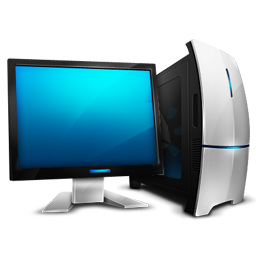
This image has format transparent PNG with resolution 256x256.
You can download this image in best resolution from this page and use it for design and web design.
Computer desktop PC PNG image with transparent background you can download for free, just click on download button.
A desktop computer is a personal computer designed for regular use at a single location on or near a desk or table due to its size and power requirements. The most common configuration has a case that houses the power supply, motherboard (a printed circuit board with a microprocessor as the central processing unit, memory, bus, and other electronic components, disk storage (usually one or more hard disk drives, solid state drives, optical disc drives, and in early models a floppy disk drive); a keyboard and mouse for input; and a computer monitor, speakers, and, often, a printer for output. The case may be oriented horizontally or vertically and placed either underneath, beside, or on top of a desk.
Full-sized desktops are characterized by separate display and processing components. These components are connected to each other by cables or wireless connections. They often come in a tower form factor. These computers are easy to customize and upgrade per user requirements, e.g. by expansion card.
Desktops have an advantage over laptops in that the spare parts and extensions tend to be standardized, resulting in lower prices and greater availability. For example, the size and mounting of the motherboard are standardized into ATX, microATX, BTX or other form factors. Desktops have several standardized expansion slots, like conventional PCI or PCI Express, while laptops only tend to have one mini-PCI slot and one PC Card slot (or ExpressCard slot). Procedures for assembly and disassembly of desktops tend to be simple and standardized as well. This tends not to be the case for laptops, though adding or replacing some parts, like the optical drive, hard disk, or adding an extra memory module is often quite simple. This means that a desktop computer configuration, usually a tower case, can be customized and upgraded to a greater extent than laptops. This customization has kept tower cases popular among gamers and enthusiasts.
Another advantage of the desktop is that (apart from environmental concerns) power consumption is not as critical as in laptop computers because the desktop is exclusively powered from the wall socket. Desktop computers also provide more space for cooling fans and vents to dissipate heat, allowing enthusiasts to overclock with less risk. The two large microprocessor manufacturers, Intel and AMD, have developed special CPUs for mobile computers (i.e. laptops) that consume less power and lower heat, but with lower performance levels.
Laptop computers, conversely, offer portability that desktop systems (including small form factor and all-in-one desktops) can not due to their compact size and clamshell design. The laptop's all-in-one design provides a built-in keyboard and a pointing device (such as a trackpad) for its user and can draw on power supplied by a rechargeable battery. Laptops also commonly integrate wireless technologies like WiFi, Bluetooth, and 3G, giving them a broader range of options for connecting to the internet, though this trend is changing as newer desktop computers come integrated with one or more of these technologies.
A desktop computer needs a UPS to handle electrical disturbances like short interruptions, blackouts, and spikes; achieving an on-battery time of more than 20–30 minutes for a desktop PC requires a large and expensive UPS. A laptop with a sufficiently charged battery can continue to be used for hours in case of a power outage and is not affected by short power interruptions and blackouts.
A desktop computer often has the advantage over a comparable laptop in computational capacity. Overclocking is often more feasible on a desktop than on a laptop; similarly, hardware add-ons such as discrete graphics co-processors may only be possible to install in a desktop.
On this page you can download free PNG images: Computer PC free PNG images download